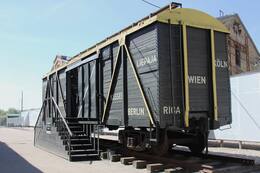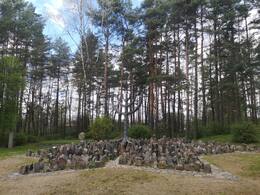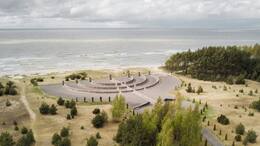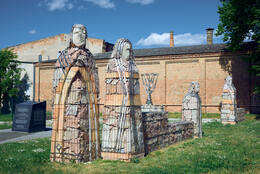Riga Ghetto and the Holocaust
Fragments of three different people's memoirs were deliberately chosen, allowing us to look more closely at the crime of the Holocaust from different perspectives.
WALTER BRUNS, a major general in the German army, observed the Rumbula operation: “The pits were 24m long and about 3m wide, you had to lie down in them like sardines in a can, your head in the middle. Six people on top with machine guns, who then shot you in the head. When I arrived, it was already full, the living had to lie on top and then they were shot; to save space, they had to lie in tight rows. [...] When they came closer, they saw what was happening in front of them. [...] They had to give up their jewelry and suitcases. The good things went into the suitcases and the rest - in one big pile, a little further away, they had to undress and 500m before the forest they had to undress completely, they were allowed to stay only in their shirts or underwear. They were all women and small children, about 2 years old.“
ŽANIS LIPKE, Jewish rescuer: “I was in a small group of people standing in horror behind the ghetto fence and watching what was happening behind the barbed wire. There was real chaos: people were helplessly rushing from one place to another, screaming, crying. Some were dragging some bundles and suitcases, others were carrying children in their arms or pushing them in strollers. Drunk policemen were shouting at people in a low voice, dragging them out of their apartments and beating them mercilessly. Some of the policemen, looking on blankly, were shooting at random – right into the crowd. [...] German soldiers and Latvian policemen were beating and shooting those who lagged behind the column. The bodies of the killed people were left on the street, along which people were being driven to be shot. In the courtyard of a large house I saw many bodies of women and babies. The house was located on Lāčplēša Street next to a barbed wire fence that was erected around "ghetto"
BAILA HAMBURGA, prisoner of the Riga ghetto, survivor of the Rumbula campaign: “People moved forward slowly, the police shouted “faster, faster”, but nothing helped. We became indifferent, the will to live died out. We walked along Maskavas Street, people stood at the windows and looked at us. Some wiped their eyes, but I also saw those who were laughing. One even showed his fist. We reached the rubber factory “Kvadrāts”, located on the city border, and walked further until we heard many shots. Now the children were crying loudly. The police were already drunk and only urged “faster, faster”.
Major General Walter Bruns (1891–1957) was a German army engineer colonel stationed near Riga in late 1941 who witnessed the mass killings at Rumbula. He was captured on 8 April 1945 and held as a prisoner in a British internment camp for German officers. These detention centres were equipped with listening devices, so that the prisoners' conversations were recorded and recorded. In one such conversation between Bruns and other officers, he spoke about the events at Rumbula, providing evidence of the Holocaust in Riga. In 1948, Bruns testified as an eyewitness in the trial of the Wehrmacht High Command. He was released from prison that same year.
Žanis Lipke (1900 – 1987) was a dock worker in the port of Riga. When the Nazis occupied Riga, he wanted to help the Jewish community. To do this, he got a job in the Luftwaffe warehouses near the Central Market near the Riga ghetto. He had to lead Jews to and from the warehouses. Lipke used this opportunity to hide some of the Jews so that they would not have to return to the ghetto, but could go to Lipke’s house, where he had already prepared a bunker for them. Later, Žanis Lipke found other places to hide Jews with acquaintances in Riga and Dobele. In total, Žanis Lipke and his assistants saved more than 50 people.
Beila Hamburga was a prisoner of the Riga ghetto who survived the Rumbula operation. She died in the Stutthof concentration camp.
The memories are published on the website of the Latvian Occupation Museum. Available: http://okupacijasmuzejs.lv/rumbula/
Related topics
Related objects
Riga Ghetto and Latvian Holocaust Museum
The Riga Ghetto and the Latvian Holocaust Museum is located in Riga close to the Riga Central Market and the Riga Central Station. The museum was opened in 2010 on the site where the city's warehouses once were. It is located in the historical part of the city, next to the border of the former Jewish ghetto. The territory of the ghetto is unique, because in terms of architecture it has not changed since World War II. It is a memorial dedicated to the tragedy suffered by the Jewish people. The German policy regarding the Jewish population in Latvia until the end of 1939 was for the German diplomats and politicians to try and pressure the Latvian government to take action against the Jews by restricting their freedom. After the emigration of the Baltic Germans in 1939, the German embassy no longer had as good an access to information on the mood of the population and the events happening in Latvia as before. When the Red Army occupied Latvia, they manipulated the society to gain some support of the Jewish population for the new occupying power. However, after the regime started a crackdown on the society as a whole, the support fell rapidly. As a result of all this, a deep divide had formed between the people. And later on, the next regime – Germany – tried to exploit it. They hoped that the local population would harass and attack the Jews, but that did not happen. So, Germany adjusted their approach and devised a new plan to initially establish a Jewish ghetto and later destroy its inhabitants.
Jewish Memorial at Rumbula
Located in Rumbula, near Maskavas Street.
Rumbula is one of the largest sites of mass extermination of Jews in Europe. During two actions – on November 30 and December 8, 1941, which were carried out based on the decision of the Nazi leadership to completely destroy the Jews imprisoned in the Riga ghetto, more than 25,000 people were shot in the Rumbula forest, including approximately 1,000 Jews deported from Germany. In 1944, several hundred Jewish men from the Kaiserwald concentration camp were also killed in Rumbula.
The first attempts to immortalize the memory of the Jews killed in Rumbula date back to the late 1960s. Despite the restrictions of the Soviet government, as a result of the initiative of individual Jews, in 1963 a wooden memorial plaque with an inscription in Yiddish was attached to one of the Rumbula pine trees, while a large poster by artist Josif Kuzkovskis “Jew” was installed near the Rumbula railway (near the Riga-Moscow line). The poster showed an image of a man who seemed to be rising from the grave with a clenched fist, symbolizing a protest against what had been done. Both the memorial plaque and the poster were removed in 1964, but the Jews managed to obtain permission to install a memorial stone in Rumbula with the inscription “To the Victims of Fascism” not only in Latvian and Russian, but also in Yiddish.
On November 29, 2002, a memorial ensemble was opened in Rumbula, designed by architect Sergejs Rižs. Its construction was financially supported by institutions from Latvia, Israel, the USA and Germany, as well as private individuals.
On the side of the highway, by the road leading to the memorial, a metal structure has been installed as a sign, symbolizing the forces of Nazism. Nearby is a stone with an explanation that thousands of Jews were driven to their deaths along this road. At the entrance to the memorial itself, several stone plaques with inscriptions in Latvian, English, German and Hebrew introduce the events of the Rumbula tragedy and the history of the establishment of the memorial. In the central part of the memorial, above the square, which is made in the shape of a Star of David, a seven-branched candelabrum rises – a menorah, around which are placed stones with the names of the Jews killed in Rumbula. The names of the streets of the former Riga ghetto are engraved in individual stones, with which the square is paved. There are several mass graves on the territory of the memorial, the places of which are marked with rectangular concrete borders.
Žanis Lipke Memorial
The Žanis Lipke memorial is located in Ķīpsala, Riga. The Žanis Lipke Museum is probably one of the most hidden museums in Riga. The obscure location of the memorial is not a coincidence and it has a symbolic meaning. It has been set up in the location of a former underground hideout that was created to save people during the German occupation of World War II. Here Žanis Lipke and his family rescued 55 Jews. Nowadays a memorial has been built next to the Žanis Lipke family house. The memorial ‘Black Shed’ is a symbolic building where shelter was provided and received. The design of the building has been taken from the historical tarred huts of Ķīpsala fishermen and sailors. These huts were built using materials from barges; hence they had a very distinct colour and tar smell. But not only the story of this historic place is unique. The way the museum communicates its message is also quite notable. The overall design has similarities with the Noah’s Ark described in the Bible, and it also resembles a boat that has been pulled ashore and overturned – a boat that has fulfilled its task. The concept of this memorial draws from the historic accuracy of this place and story and the testimonies associated with it. It is a story of a desire for freedom, unbelievable escape and trust. On your way to the museum, you’ll also be able to see the historic buildings of Pārdaugava.
Memorial to the victims of holocaust in Liepāja
The largest memorial to Holocaust victims in Latvia is located in Liepāja, in the Šķēde dunes. The memorial is dedicated to the memory of more than 3,000 Liepāja Jews killed during World War II. It is in the form of the Israeli national symbol, a seven-branched candelabra known as the menorah. The contours of the memorial, which are clearly visible from a bird’s eye view, are made of split boulders and granite blocks. The ‘lights’ of the menorah are made of granite pillars with inscriptions of verses from the Lamentations of Jeremiah in Hebrew, English, Latvian and Russian.
Memorial "Synagogue Garden"
The memorial is located in the city centre, not far from the Bauska Municipality Tourist Information Centre and Town Hall Square.
It was created thanks to the initiative and donations of the descendants of Bauska Jews living in Israel, the USA and Great Britain, as well as the support of the Bauska Municipality Council and Latvian Jewish congregations and communities.
The memorial was designed by sculptor Ģirts Burvis. It is the same size as the former Bauska Great Synagogue, and the stone images symbolise Jews coming out of the place of worship after the service. A symbolic bimah is situated in the centre of the memorial; it is a raised platform or table used in Jewish religious rituals in the synagogue. An inscription on it reads: “A tribute to the Jews of Bauska, who lived here for centuries and built this city, and who were killed by the Nazis and their local helpers in 1941. Honouring the memory of the Jewish people – the descendants of the Jews of Bauska and the people of Bauska.”
In 1935, almost 800 Jews lived in Bauska. After the Nazi occupation, in July 1941, many Jews were arrested and deported, and around 700 Jews were shot. Bauska Great Synagogue was destroyed during World War II.









